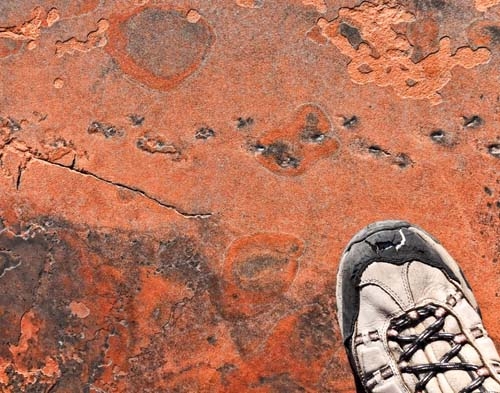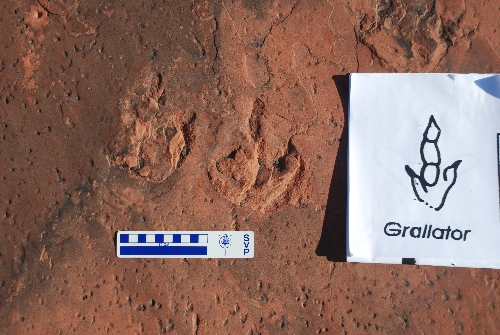Hikers stumble onto dinosaur prints at Red Rock Canyon
In 28 years with the FBI, Gary Smith never cracked a case as cold as this one.
While hiking with friends in Red Rock Canyon, Smith spotted something strange in an outcrop: smudgy impressions that hinted at three-toed feet striding across the orange sandstone.
"I knew that they were tracks, but I didn't know what they were tracks of," the 69-year-old retired special agent said. "I thought, 'I haven't seen this before.' "
The discovery is now being heralded as the first confirmed evidence of dinosaurs at Red Rock and the first fossilized dinosaur footprints ever documented in Nevada.
Experts believe the tracks were probably laid down by a two-legged, meat-eating reptile the size of a large dog, which roamed what was then a giant sand dune desert roughly 190 million years ago.
When word of the discovery leaked out recently, officials at Red Rock Canyon National Conservation Area initially said the tracks were found by park visitors in early September.
It actually happened almost a year and a half earlier than that.
REGULAR ROCK SCRAMBLERS
Gary Smith, Lynn Nicholson and Jeff Mishlove have been hiking together in Red Rock Canyon three times a week or so for the past five years.
Nicholson is a landscape photographer, trumpet player and part-time consultant. Mishlove is a businessman.
Smith met Mishlove on the trail. Mishlove introduced him to Nicholson.
On hiking days, they rendezvous at 7 a.m. at a coffee shop on West Charleston Boulevard and pick their destination.
"What do they call us? Rock scramblers?" Smith said.
Weather rarely deters them. They've been known to hike through snow or extreme heat. Their outings generally last about three hours.
On April 6, 2010, they scrambled their way up to an outcrop they had never been to before and were casually exploring the area when Smith spotted what he thought were tracks.
Soon Nicholson, 59, and Mishlove, 65, were finding footprints too -- several dozen of them in all in an area not much larger than a two-car garage.
Nicholson trained his camera at the ground and began firing away.
After they hiked back down, Smith stopped at the Red Rock visitor center and reported what they found to someone at the front desk. An email with a photo of the tracks also was sent to the U.S. Bureau of Land Management, which runs Red Rock.
When no one contacted, they figured the tracks must not be all that rare or significant.
The hikers returned to the site several times over the next year to look for more footprints and check for signs of vandalism, but they didn't make any more attempts to report their discovery.
Then Smith met Nick Saines, a geologist and naturalist for the Red Rock Canyon Interpretive Association, the nonprofit organization that helps the bureau operate the conservation area.
In August, Saines held a geology training session for Red Rock volunteers, Smith included.
Saines told the group about a certain type of sandstone in the canyon that is also found in Utah, Arizona and California and is known to contain dinosaur tracks and bones. He said it's only a matter of time before the same kind of fossils are discovered here.
"Gary came up to me after and said something to the effect of, 'I think we already found them,' " Saines recalled.
Two weeks later, Smith and Nicholson led the geologist to their outcrop. Before they even got there, Saines spotted an individual dinosaur footprint and a line of tiny tracks from an ancient arachnid.
Smith and Saines returned to the area a few days later with paleontologist and longtime University of Nevada, Las Vegas professor Steve Rowland, who quickly confirmed the find and logged still more prints.
The Red Rock Canyon Interpretive Association passed Rowland's findings on to the BLM, and this time the message got through.
On Oct. 29, the bureau staged an expedition to the site, where a team of researchers used special cameras to take three-dimensional images of the fossilized prints.
A 190 MILLION-YEAR-OLD SECRET
So far, Red Rock officials have declined to disclose the exact location of the tracks.
Smith and Nicholson aren't saying either. All they will say is the site can be reached by a moderately good hiker in as little as an hour, but it requires some rock scrambling to get through several tricky spots.
After his hike there in the heat of the summer, Saines described the area as "very rugged" but offered few other details.
"We certainly don't want to reveal it to the public until such time as all the scientific work has been done. That's a given," Saines said.
If it had been up to Nicholson, not even the BLM would know about it.
He wanted the three of them to keep the discovery to themselves, but he told Smith he would support whatever he decided to do about the tracks.
"I would have never told anyone," Nicholson said. "The only way to protect it is to keep it a secret forever."
He wound up paying a price for those footprints. During the hike to the site with Smith and Saines in late August, he fell and broke his ankle in three places.
Nicholson said he was moving too quickly in the mounting heat and took a bad step.
"Normally I'd walk out on something like that, but I put my foot down and the leg just went crunch," said Nicholson, who is the most experienced of the three hikers. "It just wouldn't support the weight."
He had to be picked up and flown out of the canyon by a rescue helicopter.
He said his ankle is now full of hardware, but he recently started hiking again.
As Saines joked: "Dinosaurs don't give up their secrets easily."
RESEARCHERS GET READY
Smith shrugs off the 17 months that passed between his initial report and confirmation of the discovery. He has no hard feelings about the delay. After 190 million years, what's the difference?
"I probably didn't communicate it well, and I didn't follow up," he said. "It got lost in the cracks for some reason."
Asked what he hopes to see done with the site, Smith said he trusts BLM officials to find a way to share it with everyone while somehow keeping it safe.
Tim Wakefield, BLM's field manager at Red Rock Canyon, said his agency has the same goals in mind, but the specific plan is still a work in progress.
Staff members hope to post some photographs and information about the tracks at the Red Rock visitor center by year's end and follow that with "the big roll-out" of a more permanent display sometime in January, Wakefield said.
As far as he is concerned, Smith, Nicholson and Mishlove deserve credit both for what they found and what they did after they found it. He said their decision to report the find and keep the location a secret showed their professionalism and their love for Red Rock Canyon.
"They're trying to keep it low key, but they're busting out," Wakefield said of the hikers. "They're excited about being part of this discovery, and rightly so."
BLM officials have not decided whether to disclose the location of the footprints. If that ever happens, it won't be done until the scientific work is finished, Wakefield said.
A UNLV doctoral student, Heather Stoller, hopes to do that work.
Rowland said Stoller plans to submit a research proposal to the BLM within a week. "This will be her doctoral thesis."
Assuming she gets a permit from the BLM, the research will be done this winter and spring and involve comparing the sandstone where the tracks were found to similar rock formations at Zion National Park and elsewhere. It's all part of the "same big desert sand dune deposit," Rowland said.
Meanwhile, he is getting ready to publish a paper on slightly newer fossilized tracks from a small "proto-mammal" he has been studying for the last several years at Valley of Fire State Park.
Apart from their scientific significance, the dinosaur tracks at Red Rock could spark public interest in the region's geology and paleontology, Rowland said.
He favors anything that gets people thinking more about what happened here, he said with a laugh, "long before Mugsy Siegel, Bugsy Siegel, whatever his name was."
After all, getting people excited about fossils can lead them to go out and actually find them.
"It's not a huge surprise to find tracks in the Aztec sandstone. It's a bit of a surprise they weren't found sooner," Rowland said. "It took someone with a keen eye."
Smith and Nicholson said they have no plans to change their routine in the wake of their discovery. They won't be making any special trips to look for more fossils.
But they will be out there hiking the sandstone of Red Rock Canyon a few days a week. And occasionally, they will have to look down.
Contact reporter Henry Brean at hbrean@reviewjournal.com or 702-383-0350.
More to be discovered
The recent discovery of dinosaur tracks at Red Rock Canyon National Conservation Area is merely the latest example of a significant find being made by visitors on public lands.
Now that fossilized footprints from the early Jurassic period have been confirmed at Red Rock Canyon, experts expect more discoveries to be made there.
The U.S. Bureau of Reclamation is asking anyone who finds what they believe to be tracks or other fossils on public land to call 702-515-5350 as soon as possible and provide the location and photographs of the site.
The bureau is also reminding visitors that it is illegal to dig, remove or collect vertebrate fossils without a permit. To avoid damaging paleontological resources, never drive over, walk on or sit on fossils and never take molds or castings or apply anything to them.
Las Vegas Review-Journal


















